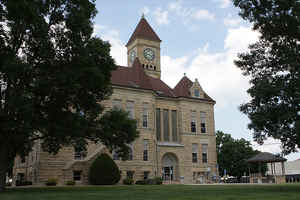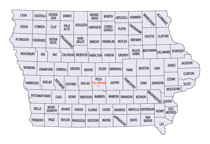Iowa Counties
There are ninety-nine counties in Iowa. The first two counties, Des Moines County and Dubuque County, were created in 1834 when Iowa was still part of the Michigan Territory. In preparation for Michigan's statehood, part of Michigan Territory was formed into Wisconsin Territory in 1836]. Two years later, the western portion was split off to become Iowa Territory. The south-eastern part of Iowa Territory became Iowa, the 29th state in the union, on 28 December 1846, by which point 44 Counties had been created. Counties continued to be created by the state government until 1857, when the last county, Humboldt County, was created.Grundy County, Iowa
Grundy County Education, Geography, and History
Grundy County is a county located in the state of Iowa. Based on the 2010 census, the
population was 12,453. Grundy County was
created on January 15, 1851. The county
seat is Grundy
Center. The county is named for Felix Grundy, former United States Attorney General.
Grundy County is included in the Waterloo-Cedar Falls, IA Metropolitan Statistical Area.
Etymology - Origin of Grundy County Name
Grundy county is named for Felix Grundy, an United States Attorney General and United States Senator from Tennessee.
Demographics:
County QuickFacts: CensusBureau Quick Facts
Grundy County History
Grundy County, named for US
Senator, cabinet member and chief justice of the Kentucky Supreme Court Felix H.
Grundy, was established in 1851 and organized in 1856. Grundy Center became the
county seat in 1856, when it was called Belpre. Belpre was taken from belle and
prairie, signifying a beautiful prairie.
Grundy County developed rapidly from 1860 - 1890 as thousands of acres of native
prairie sod were broken for cropland. The population grew rapidly during this
period, reaching 13,215 by 1890. The 2000 census for Grundy was 12,369.
The first Courthouse, octagonal in shape, was nicknamed the "cheese box" because
it resembled a giant cheese box. The Board of Supervisors held their first
meeting in the building on January 7, 1861. The Courthouse was a two-story
wooden building, and it stood in the center of the block, on the spot now
occupied by the present building. The lower level was divided into two equal
parts by a hallway running north and south, and each half was partitioned into
two equal parts. The room in the northeast corner was used as an office for the
County Treasurer and the County Recorder, and the other room was the Sheriff's
Office. On the west side of the hall, the south room was the office of the Clerk
of Court, and the north room as the County Auditor's Office. The upstairs was
divided into a Courtroom and small Jury Room. The Courtroom was also used for
church services in the 1860's.
By 1890, the need for a new Courthouse, larger and more up to date, was evident.
On February 24, 1891, a special election was held on the question of building a
new Courthouse. The vote carried more than two to one.
The cornerstone for this Grundy County landmark was laid November 11, 1891. The
special ceremonies for the laying of the cornerstone was conducted by the
Masonic Lodge, under the supervision of the County Board. School children were
invited to join in the march around the Courthouse Square. Speakers at the
ceremonies rejoiced with the rest of the crowd that a little of the great wealth
of Grundy County was going into a fine Courthouse.
The architects for the Courthouse were W. L. Kramer and E. E. Zoll from Findley,
Ohio. The building contractor was T. B. Seeley, Son & Company from Fremont,
Nebraska.
The basement walls are made of stone from Stone City, Iowa. The upper walls are
made from sandstone from Cleveland, Ohio, and the steps are made from a harder
stone from Keosota, Minnesota.
It was reported that the contractor lost between $7,000 and $8,000 on the
Courthouse project. That was largely due to a provision in the contract which
required them to have all the stone cut on site, to guard against any of the
stone being marred in shipment. The stone was shipped from Ohio in huge blocks.
The contractor had no machinery for hauling such heavy loads, so it was
necessary to cut these blocks into smaller pieces before they could be taken
from the railroad yard to the Courthouse Square, where they could be cut into
shape for use in the walls of the building. The wages paid to the stone cutters
were the highest paid by any contractor in the state.
In 1895 the new Courthouse was finished and furnished, and there was money in
the treasury to pay all the bills without a bond sale.
The clock was installed in the tower in 1900 to add the finishing touch on the
new Courthouse.
Source: Mary Schmidt, Grundy County Auditor, 2002
Geography: Land and Water
As reported by the Census Bureau, the county has a total area of 502 square miles (1,300 km2), of which 502 square miles (1,300 km2) is land and 0.04 square miles (0.10 km2) (0.01%) is water.
Grundy county is located close to the center of Iowa.
Neighboring Counties
Bordering counties are as follows:
- North: Butler County
- East: Black Hawk County
- Southeast: Tama County
- Southwest: Marshall County
- West: Hardin County
- Northwest: Franklin County
Education







